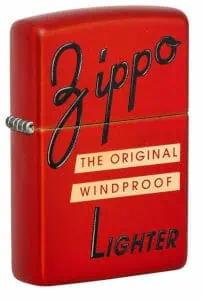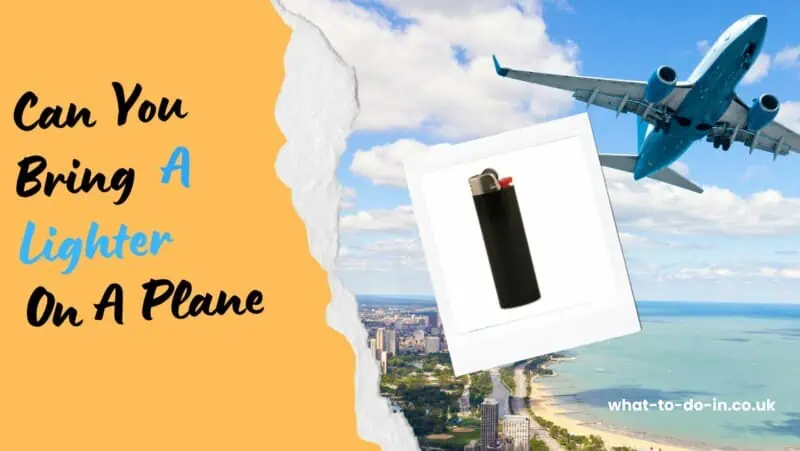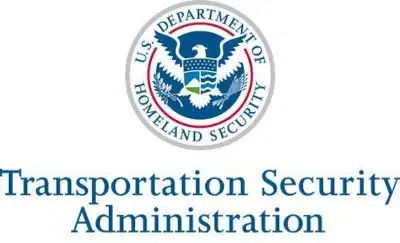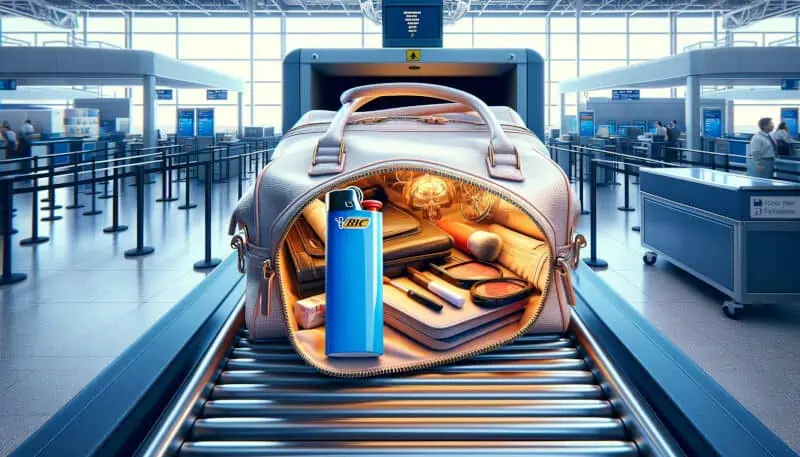Every day, millions of passengers travel by air, many of whom are smokers or carry lighters for other purposes. The question of whether one can bring a lighter on a plane is not just a matter of convenience but also of safety and security.
The regulations surrounding the transportation of lighters have evolved over time. In the wake of increased security measures, especially after the events of September 11, 2001, the Transportation Security Administration (TSA) in the United States, along with other international security agencies, implemented strict guidelines on what passengers can carry on board. Lighters, being potential fire hazards, fell under intense scrutiny. Initially, all lighters were banned from carry-on luggage and checked baggage. However, recognizing the inconvenience to travelers, the rules were later adjusted to allow certain types of lighters in carry-on luggage, while still maintaining a ban on others to ensure in-flight safety.
One compelling statistic that highlights the importance of these regulations is the sheer volume of passengers traveling by air. According to the International Air Transport Association (IATA), the aviation industry transported over 4.5 billion passengers in 2019. With such a high number of individuals in transit, even a single incident involving a lighter could have serious repercussions. Therefore, the rules are designed to minimize risk while still allowing for some level of personal convenience.
Can You Take a Lighter on a Plane?
When it comes to air travel, the rules regarding what you can and cannot take on a plane are quite strict due to safety concerns. For lighters, the Transportation Security Administration (TSA) allows passengers to carry one lighter on their person or in their carry-on baggage. However, this is limited to disposable Bic or Zippo lighters without fuel reservoirs containing unabsorbed liquid fuel, except for lighters that are completely empty. Torch lighters or lighters with a blue flame are not permitted in carry-on or checked baggage. It’s important to note that the regulations can vary by country and airline, so it’s always best to check with your airline before traveling. In the following sections, we will delve deeper into the specifics of these regulations, provide tips for traveling with lighters, and discuss the potential consequences of not adhering to these rules.
Regulations on Lighters for USA Domestic Flights
Travelers on USA domestic flights need to comply with regulations concerning the transport of lighters. Regulations are enforced by the Transportation Security Administration (TSA) to ensure the safety of passengers and the aircraft. These rules dictate what type of lighter you can carry and how to transport them.
TSA Lighter Rules
Disposable Bic and Zippo lighters without fuel are allowed in checked luggage.
- Electronic, battery-powered, and absorbed-fuel lighters (like a Zippo) with fuel can be transported in carry-on luggage or on your person.
- Up to two fueled lighters are permitted if properly enclosed in a DOT-approved case.
- Lighter fluid and butane refills are not permitted in checked or carry-on luggage.
For the most up-to-date regulations, travellers should always check the TSA website before packing. (TSA – Lighters). These are general guidelines and can change based on the threat level or other factors.
Packing Lighters in Checked Luggage
- You may pack disposable Bic and Zippo lighters without fuel in checked luggage.
- Lighters with fuel are not allowed in checked baggage, unless they are in a DOT-approved case.
These measures are in place to prevent accidental ignition of the lighter while in the cargo hold of an aircraft.
Carrying Lighters on Your Person or in Carry-On
- A single book of safety matches can be carried on your person.
- Certain lighters with batteries can be packed in carry-on luggage, but passengers may be asked to remove the batteries or take extra measures to ensure they are safe to carry on board.
Passengers should note that while most common lighters are allowed in carry-on luggage, torch and blue flame lighters are generally prohibited. Check the TSA website for specifics.
Storing Lighters in a DOT-Approved Case
Up to two fueled lighters are allowed if they are enclosed in a DOT-approved case. This is a special type of case designed to contain the lighter and prevent any accidental ignition.
Prohibited Items Related to Lighters
- Lighter fluid and butane refills are prohibited on board any aircraft, either in carried or checked luggage.
- Strike-anywhere matches, “permanent” matches, novelty lighters, and lighter replicas that resemble a weapon are all forbidden from flights.
If you’re unsure whether your item is permitted, you can check the TSA’s “What Can I Bring?” tool or contact them directly for clarification.
International Air Transport Association (IATA) Guidelines
The International Air Transport Association (IATA) provides guidelines for passengers traveling with lighters. According to IATA regulations:
- Passengers are typically allowed to carry one lighter on their person.
- The lighter must be intended for personal use.
- Lighters should not be checked in with baggage.
- Lighter fuel and lighter refills are not permitted on board the aircraft.
- Torch lighters, also known as blue flame lighters or cigar lighters, are forbidden in both carry-on and checked baggage.
For more detailed information, passengers should refer to the IATA Dangerous Goods Regulations or contact their airline directly. (IATA Website)
Country Specific Regulations
When it comes to traveling by air with lighters, regulations can vary significantly from country to country, as well as by airline. Generally, most aviation authorities allow passengers to carry one lighter on their person or in carry-on luggage, but this is subject to strict conditions.
United Kingdom
In the UK, passengers are allowed to carry one small cigarette lighter on their person. However, it must be kept on the passenger throughout the flight and not placed in carry-on or checked luggage. For more details, refer to the UK government’s official guidelines. (UK Government Page)
Europe
European regulations align with IATA standards, permitting one lighter per person. The European Union provides comprehensive safety guidelines for passengers carrying lighters. (EU Aviation Security Policy)
Canada
Transport Canada allows passengers to carry a lighter on their person but not in checked or carry-on baggage. Specific details can be found on the Transport Canada website. (Transport Canada)
Australia
The Australian Government’s Department of Home Affairs outlines that a single lighter can be carried on a person but not in checked luggage. For further information, consult their official guidelines. (Department of Home Affairs)
New Zealand
Civil Aviation Authority of New Zealand permits passengers to carry a lighter with them on board but not in checked baggage. More information is available on their website. (CAA New Zealand)
Asia
Asian countries may have varying regulations, but they generally follow IATA guidelines. Passengers should check with the specific country’s civil aviation authority for accurate information.
Singapore
The Civil Aviation Authority of Singapore allows passengers to carry a lighter on their person. However, it is prohibited in both checked and hand luggage. Details can be found on their website. (CAAS Singapore)
10 Airline-Specific Regulations for Flying with a Lighter
Below are the regulations from 10 different international airlines regarding flying with lighters:
American Airlines
- One lighter per passenger is allowed when carried on the person.
- Lighters are not permitted in checked or carry-on baggage.
- For more information, visit the American Airlines website. (American Airlines Baggage Policies)
Delta Air Lines
- Passengers may carry one lighter with them on the flight.
- Lighters are not allowed in checked luggage.
- Refer to Delta’s baggage restrictions for further details. (Delta Baggage Restrictions)
United Airlines
- United permits one lighter on the person but not in baggage.
- Additional restrictions can be found on their website. (United Airlines Baggage Information)
Emirates
- Emirates allows lighters to be carried on the person only.
- For more specifics, check the Emirates baggage policies. (Emirates Baggage Policies)
Lufthansa
- Lufthansa allows one lighter per passenger, to be kept on the person.
- Check Lufthansa’s website for more information. (Lufthansa Baggage Regulations)
Air France
- Air France permits a single lighter on the person.
- Visit Air France’s website for detailed guidelines. (Air France Baggage Information)
Qantas
- Qantas allows passengers to carry a lighter on their person.
- Lighters are not permitted in checked or carry-on bags.
- For more details, refer to the Qantas website. (Qantas Carry-On Baggage)
Cathay Pacific
- Cathay Pacific permits carrying a lighter on the person.
- For additional information, consult their baggage policies. (Cathay Pacific Restricted Items)
Singapore Airlines
- One lighter may be carried on the person during the flight.
- For more comprehensive guidelines, visit the Singapore Airlines website. (Singapore Airlines Baggage Restrictions)
British Airways
- British Airways allows a lighter to be carried on the person.
- Lighters are not allowed in checked or hand luggage.
- For further details, check the British Airways website. (British Airways Prohibited and Restricted Items)
Packing a Lighter in Carry-On Luggage
- Use a DOT-approved lighter case – If you are bringing a lighter on board, ensure it is enclosed in a Transportation Department-approved case.
- One lighter per person – Passengers are usually allowed to bring one disposable Bic or Zippo lighter.
- Prohibited lighters – Torch lighters, also known as jet lighters and blue flame lighters, are not allowed in carry-on or checked luggage.
- Place in a quart-sized bag – If your lighter is not in a case, it must be in your clear, quart-sized liquids bag alongside your other gels and aerosols.
Packing a Lighter in Hold Luggage
Storing a lighter in checked baggage is more restrictive. It is generally forbidden to pack lighters with fuel in your hold luggage due to safety concerns.
- Banned lighters – All lighters with fuel are not permitted inside checked baggage.
- Safety matches – You may pack one book of safety matches in your hold luggage, but this is the exception rather than the rule for items that can create a flame.
- Empty lighters – Some airlines may allow empty lighters in checked bags, though it’s rare and you should check with your airline prior to packing.
Special Circumstances
- Lighters with a removable fuel source – Lighters with a removable fuel cell might be permitted in checked luggage provided the fuel cell is removed and carried on your person.
- Collector’s lighters – Antique or collectors’ lighters without fuel may generally be stored in checked luggage.
Best Practices for Packing a Lighter
- Check with your airline – It’s always a good idea to check the specific regulations of the airline you are flying with, as they may have additional restrictions.
- Place the lighter in an accessible spot – If you are carrying a lighter in your carry-on, pack it in an easily accessible location in case TSA agents need to inspect it.
- Consider mailing – If you’re traveling with collectible or non-standard lighters, you might want to consider mailing them to your destination to avoid any problems during your flight.
Essential Carry-on Items Similar to a Lighter

FAQ’s About Taking a Lighter on a Plane?
Travelers often have questions regarding the regulations pertaining to the carriage of lighters on aircraft. These Frequently Asked Questions (FAQs) aim to clarify the rules and provide guidance on what types of lighters are permitted, where they should be packed, and related considerations when flying. Understanding these regulations is essential for a smooth and hassle-free travel experience.
Can I bring a disposable lighter on a plane?
Yes, you can usually bring one disposable lighter on a plane in your carry-on baggage, but it should not be put in your checked luggage.
Are Zippo lighters allowed on flights?
You are allowed to bring a Zippo lighter onto a plane in your carry-on baggage, but it must be completely empty if placed in your checked baggage.
How many lighters can I carry on a plane?
Regulations typically only allow one lighter per person on a plane. It must be kept on your person or in your carry-on baggage.
Am I allowed to carry a torch lighter on an airplane?
No, torch lighters, also known as torch lighters or blue flame lighters, are generally not allowed on airplanes due to their intense flame.
Can I bring matches on a plane?
One book of safety (non-strike anywhere) matches is usually permitted on a plane, but must be carried on your person or in your carry-on baggage, not in checked luggage.
Are lighter fluids allowed in checked or carry-on baggage?
Lighter fluid and other refills for lighters are not usually permitted in checked or carry-on baggage due to their flammable nature.
Can I use my lighter or matches on the plane?
No, for safety reasons, you are not allowed to use lighters or matches at any time during a flight.
Do different airlines have different rules for lighters?
While general aviation regulations set by transportation authorities tend to be consistent, individual airlines may have their own policies, so it’s best to check with your airline before traveling.
Are electronic cigarettes and their lighters allowed on planes?
Electronic cigarettes and vaping devices are usually allowed in carry-on luggage but must not be used or charged on the aircraft. The lighters specifically for these devices follow the same rules as other lighters.
What can happen if I pack a lighter incorrectly?
If you pack a lighter in your luggage that is not allowed or not packed correctly according to regulations, it may be confiscated, and you could be subject to fines or other sanctions.
Packing It All Up
In essence, transporting a lighter on an airplane is subject to very specific regulations that travelers must adhere to. Passengers are typically allowed to bring one lighter with them onboard in their carry-on baggage or on their person. However, it must be a standard disposable Bic or Zippo lighter, while torch lighters, also known as jet lighters and blue flame lighters, are prohibited due to their higher intensity flame. It’s paramount to note that lighters cannot be placed in checked luggage, and any lighter fluid or lighter refills are not permitted on the flight at all, enforcing a clear distinction between what is considered safe for flight and what poses a potential hazard.
Moreover, for safety reasons and in accordance with the Transportation Security Administration (TSA) regulations, “strike anywhere” matches are banned, whereas one book of safety matches can be brought on the person. The guiding principle behind these rules is to minimize the risk of accidental fires on aircraft, ensuring the safety and security of the flight and its passengers. Compliance with these regulations is mandatory, and travelers must familiarize themselves with these rules to avoid any inconvenience or security issues at the airport, ensuring a smooth and hassle-free travel experience.


 Disposable Bic and Zippo lighters without fuel are allowed in checked luggage.
Disposable Bic and Zippo lighters without fuel are allowed in checked luggage.



